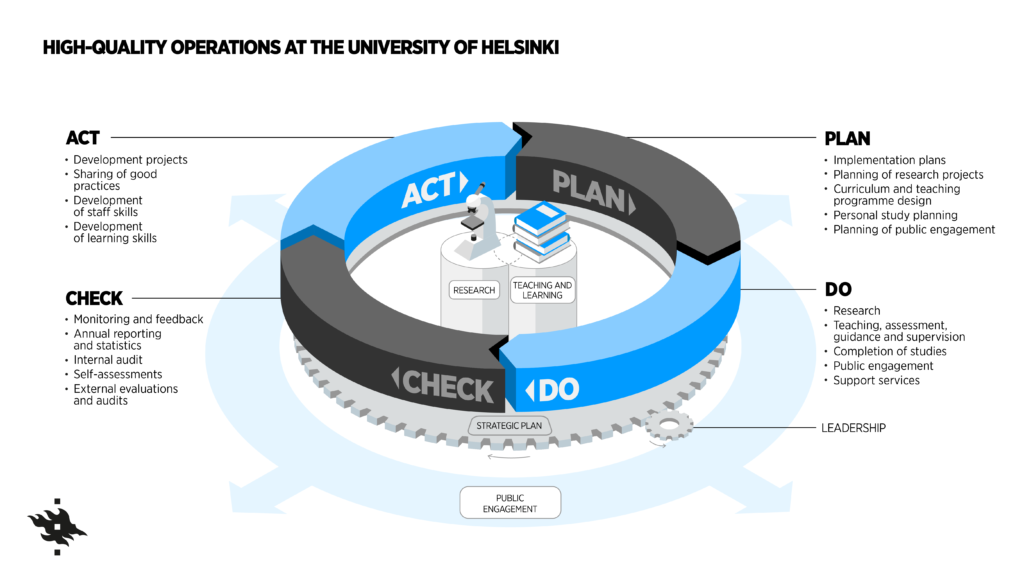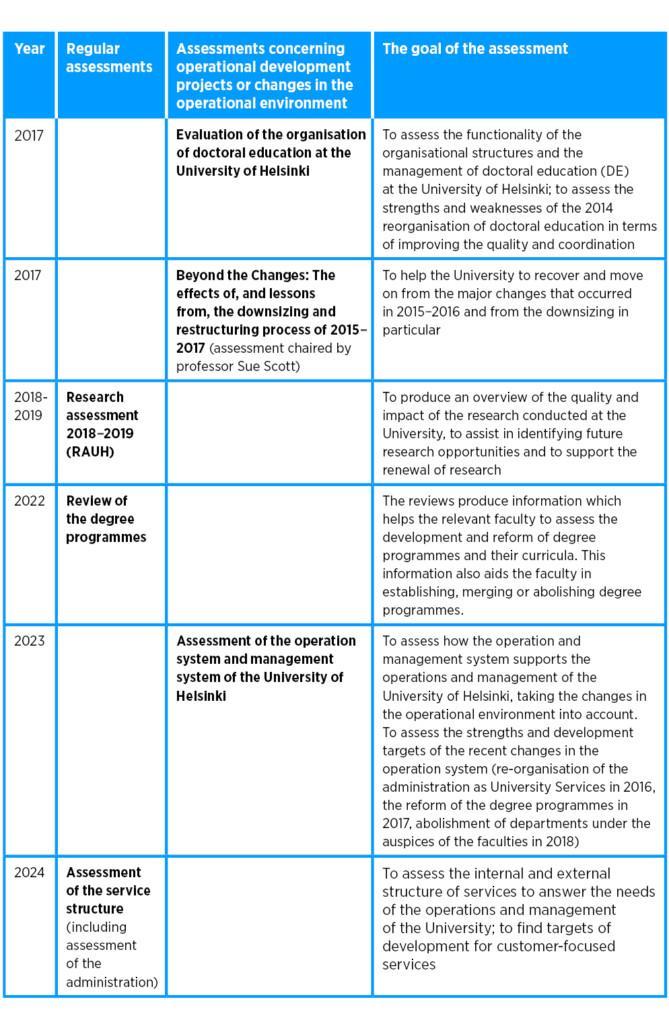PDCA model is well integrated in the activities, but further development is still needed
The university’s integrated management system covers education, research and innovation activities, societal engagement and support services. A good development has been to use the PDCA cycle as the guiding principle and describe the different aspects of the core duties according to that logic on Flamma (the quality cycle/navigators). The key processes of research and teaching at the university are well managed with a set of performance indicators and follow-up of the performance.
The operations planning process ensures a university-level systematic approach to societal engagement (public engagement), which would otherwise be lacking. Better university-level indicators could be used to follow up on the key strategic focus areas, in addition to ‘Share of student feedback respondents (Bachelor’s Graduate Survey)’, ‘Share of international students pursuing a master’s degree’ and ‘High-quality and international open-access publications’, now used in the annual follow-up of operations plans.
In general, the PDCA model seems to be used well throughout the various levels of operations, but collecting and using feedback information (Check) in recognition of the development needs of the operations (Act) could still be enhanced. In particular, the ‘Act’ part will need further attention from the university. At the moment, the process from data to actions and the follow-up of the actions could be improved. One reason is that the responsibilities for closing the PDCA or feedback loop, i.e., that actions are taken and followed up, are not always clear enough. The ongoing process of creating process descriptions could bring more clarity to this.
On the other hand, the audit evidenced a reflective quality culture based on an active collection of different types of data in the form of statistics, surveys, annual reviews, audits, periodic evaluations, etc. The university has good, perhaps too many, digital tools in place to facilitate different processes, data collection and monitoring of data. There was evidence that various information was used to identify challenges and development areas in the university’s activities and for improvement. Innovative approaches, such as the thematic benchlearning exercise with the University of Edinburgh, which was part of the audit, are welcome and provide tools for the improvement and development of activities and processes.
Postdocs represent a crucial group for long-term development of research environments
Audit interviews provided a strong indication of a systematic and professional approach in the development of research and innovation activities. For instance, the staff recognised the great developments that have taken place at the university in developing innovation services and support for building research cultures. It was recognised in discussions with staff that the development and renewal of science often begins with projects with PhD students and postdocs. There was a strong agreement among several staff members that the single thing that would best support the university in advancing its research would be to focus the support on its postdocs. Sustainable and flexible solutions for their employment, such as 50/50 contracts with companies, would be needed to ‘keep the best brains’ at the university.
A quality culture is well on its way
The quality culture at the university is open and there are many opportunities for members of the university community to get engaged in the development of the university. The audit team appreciated the self-critical and open culture for discussion and collaboration, which was also highlighted especially by staff members. In general, opportunities for staff to influence and participate in the development of the university were considered good. However, from the faculty staff point of view, the quality work of the university is not that visible to everyone. There seems to be ambiguity in the concept of the university’s quality system, which perhaps could be explained by the relatively recent developments in renewing the system and by how the system is presented.
One challenge, which is also discussed in Chapter 4, is that the international staff do not have the same opportunities to participate at the university. This was brought up as a challenge in some discussions with staff. While the university is to be commended for being very good at producing information and materials in Finnish, Swedish and English, for instance on the Flamma website, the main administrative language of the university is still Finnish. The challenge in terms of languages does create unequal opportunities among its staff. The university seems to be well aware of this challenge. For instance, the issue of ‘active and full community participation regardless of language or cultural background’ has been addressed in the annual operations plans.
Student representation is at a good level at the university. A general challenge, which does not concern only the University of Helsinki, is that it is sometimes hard to find student representatives. There are many programmes at the university and sometimes it is difficult to get positions filled, especially in fields with a small number of students. The university has tried to boost student engagement by clarifying from what kinds of duties students can get credits and be paid when contributing to the university. The student representatives are appointed by the student union and play an important role in providing the student perspective on many different issues. The rectorate interacts with student representatives regularly. The student union seems more distant to students than the student associations, which play an important but informal role in relation to channelling student experiences and needs. One area where the university could improve is the representation of doctoral students, which is good at the level of doctoral schools and doctoral programmes, but perhaps could be strengthened at the faculty and university levels. There also appears to be a need for more information among the doctoral students concerning the division of responsibilities between the doctoral schools and faculties.
The identification of external stakeholders seems to mainly arise from traditional partners of the units through a bottom-up approach. To some extent there seems to be a lack of systematic analysis and identification of the key national and international stakeholders, resulting in building on tradition and to a certain degree in a sometimes haphazard community engagement. A more systematic stakeholder analysis would enable the university to identify its key stakeholders for the entire university and its various units as well as the type of cooperation with each of the stakeholder groups. This would also help monitoring the effectivity of community engagement.
The feedback culture will need to be strengthened
Apart from the formal participation of the student representatives, there seems to be a culture of good informal contact with teachers where it is relatively easy for students to talk to or email lecturers about their needs. Although several channels for student feedback are used and have a central role in the quality management and development of teaching and learning, as discussed in Section 1.3, the system is not working as well as it could. Several students, including international and doctoral students, met by the audit team were uncertain whether their feedback had an impact, and when they were heard, if their views were considered. Although the audit gave the impression that the university and most of the staff value student feedback and student engagement highly, there seems to be pockets at the university where the feedback culture does not reach all the way. There is a need for the university to strengthen the feedback culture and close the feedback loop.
In addition, the university could better use opportunities in collecting and taking advantage of external views on university operations. In the fields of education of professionals, such as medical doctors, primary and secondary school teachers, veterinarians and lawyers, communication and cooperation are active with hospitals, schools and other employers of the professionals. But in the fields where employment places for graduates are not so obvious, there could be more room for active outreach and feedback collection from well-defined external parties.
There is evidence of systematic development of the system, but efforts are still needed by the university to simplify the integrated management system and forming it into one holistic system without separate components. The audit team was pleased to note that several of the improvement areas identified in the audit have already been identified as action points in connection to the strategic focus areas. This indicates a good awareness of the university of its challenges, a well-functioning system to gather information on the university’s activities, and a capability of the institution to take the actions required for further improvement.



